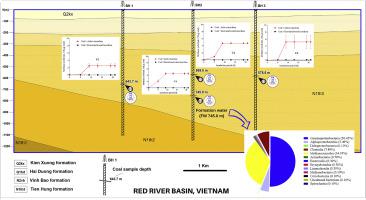International Journal of Coal Geology ( IF 5.6 ) Pub Date : 2021-01-02 , DOI: 10.1016/j.coal.2020.103674 Lan Hoang , Thi Thuy Phung , Michael Urynowicz , Kim Anh To , Quoc Hung Le , Zaixing Huang , Hong Thanh Lai , Qiurong Wang , Rizwan Haider , Lan Huong Nguyen

|
The generation of biogenic methane from coal mines is considered a sustainable approach for enhancing the recovery of natural gas from coalbeds. This study aims to provide the first quantitative data about the characteristics of coal samples, microbial community, and biogenic methane potential in coal mines located in the Red River Basin (RRB), Vietnam. Coal samples from the RRB were characterized and classified into Lignite B and Subbituminous A. Formation water (FW) and coal samples from the investigated boreholes were also analyzed and characterized for microbial communities. Bacterial communities were found to be more dominant (65.8%) than archaea (34.2%) in the FW sample. Four bacterial phyla, including Proteobacteria, Firmicute, Actinobacteria, and Bacteroidetes, were found in the FW sample, in which Proteobacteria were the most abundant phylum, accounting for 56% of total identified bacteria. In the Proteobacteria phylum, only Alphaproteobacteria, Deltaproteobacteria, and Gammaproteobacteria were found in the FW sample; and Gammaproteobacteria were the most abundant class (50.5%). At the genus level, more than 30 microbial genera were detected in the FW sample with the relative abundance >0.1%, in which Shewanella was the most abundant genus, followed by uncultured Rhodobacteraceae, Paracoccus, and Pseudomonas. The microbial population in the coal sample was less diverse than that in the FW sample. The final methane yields after 21 days of incubation with coal samples varied from 2.51 to 5.21 mL of methane per gram coal, exhibiting the great potential for the biotransformation of coal to methane. The results of this study have shown that the presence of indigenous microbial consortia along with available substrates can play an important role in the generation of biogenic methane in coal mines.
中文翻译:

越南红河流域煤矿中微生物多样性和生物甲烷潜力的首次调查
从煤矿产生生物甲烷被认为是增强从煤层中回收天然气的可持续方法。这项研究旨在提供有关越南红河盆地(RRB)煤矿中煤样品,微生物群落和生物甲烷潜力的第一份定量数据。对来自RRB的煤样品进行了表征,并分类为褐煤B和亚烟煤A。还对来自调查井眼的地层水(FW)和煤样品进行了分析和表征,以了解微生物群落。在固件样本中,细菌群落比古细菌(34.2%)更占优势(65.8%)。在FW样本中发现了四个细菌门,包括变形杆菌,硬毛,放线菌和拟杆菌。其中,Proteobacteria是最丰富的门,占已鉴定细菌总数的56%。在门氏杆菌中,仅FW样品中发现了Alphaproteobacteria,Deltaproteobacteria和Gammaproteobacteria。丙型和丙型细菌最多(50.5%)。在属水平上,在FW样品中检测到30多个微生物属,相对丰度> 0.1%,其中希瓦氏菌是最丰富的属,其次是未培养的红细菌科,副球菌和假单胞菌。煤样品中的微生物种群比FW样品中的微生物种群少。与煤样品一起培养21天后,最终的甲烷产量为每克煤2.51至5.21 mL甲烷,这显示了将煤生物转化为甲烷的巨大潜力。这项研究的结果表明,土著微生物聚生体的存在以及可利用的基质在煤矿中生物甲烷的产生中起着重要作用。



























 京公网安备 11010802027423号
京公网安备 11010802027423号